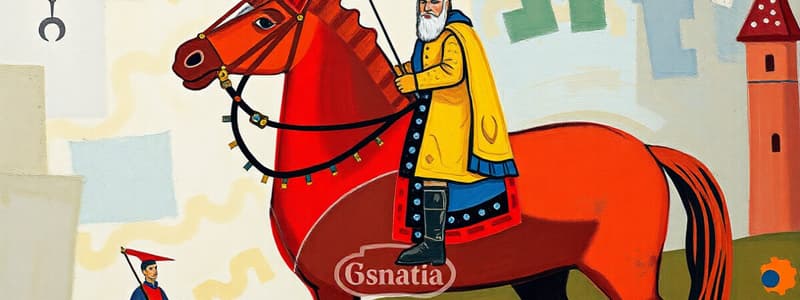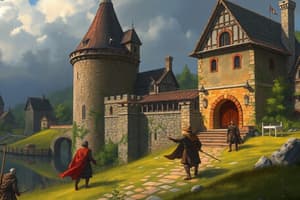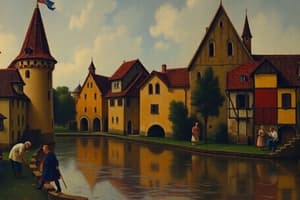Podcast
Questions and Answers
What was one primary reason for the development of the code of chivalry in Europe during the Middle Ages?
What was one primary reason for the development of the code of chivalry in Europe during the Middle Ages?
- To create a sense of honor among warriors (correct)
- To promote trade among the nobles
- To establish laws for peasants
- To encourage alliances between kingdoms
The use of leather saddles and stirrups had no significant impact on medieval warfare.
The use of leather saddles and stirrups had no significant impact on medieval warfare.
False (B)
What role did mounted knights play in medieval armies?
What role did mounted knights play in medieval armies?
They were the most important part of an army, capable of charging into enemy lines.
The code of chivalry glorified both __________ and romantic love.
The code of chivalry glorified both __________ and romantic love.
Match the following terms related to medieval warfare and culture:
Match the following terms related to medieval warfare and culture:
Which of the following describes the economic role of peasant women in medieval households?
Which of the following describes the economic role of peasant women in medieval households?
Daughters in rich households received practical household skills education from their mothers.
Daughters in rich households received practical household skills education from their mothers.
What were two inventions from Asia that changed technological warfare in western Europe?
What were two inventions from Asia that changed technological warfare in western Europe?
The code of __________ influenced the behavior and mentality of knights during the feudal period.
The code of __________ influenced the behavior and mentality of knights during the feudal period.
Match the following terms with their significance:
Match the following terms with their significance:
Flashcards
Chivalry
Chivalry
A code of behavior for knights, glorifying combat and romantic love.
Knights
Knights
Warriors on horseback, becoming crucial in medieval warfare
Stirrups
Stirrups
Developed in Asia, enabling knights to ride and fight effectively.
Saddles
Saddles
Signup and view all the flashcards
Medieval Warfare
Medieval Warfare
Signup and view all the flashcards
Peasant Women's Roles
Peasant Women's Roles
Signup and view all the flashcards
Chivalry in Society
Chivalry in Society
Signup and view all the flashcards
Medieval Inventions
Medieval Inventions
Signup and view all the flashcards
Knights' Roles in Feudalism
Knights' Roles in Feudalism
Signup and view all the flashcards
Noblewoman vs. Peasant Woman
Noblewoman vs. Peasant Woman
Signup and view all the flashcards
Study Notes
European Middle Ages (500-1200)
- Charlemagne and Otto the Great attempted to revive the Roman Empire
- The fall of Rome led to many small kingdoms
- Weak rulers and a decline in central authority led to feudalism
- Local lords, with large estates, gained power
- Power struggles arose between local lords and the Church
- The Church was a unifying force, shaping people's beliefs and daily lives
- Most Europeans shared a common faith
- Rome remained the seat of the Roman Catholic Church after the fall of the Roman Empire in AD 476
- Six major kingdoms existed in western Europe around AD 500
- Clovis united the Franks under Christian rule (AD 511)
- Charles Martel stopped Muslim invasion (AD 732)
- Pope Leo III crowned Charlemagne emperor (AD 800)
Invasions of Western Europe
- Germanic invaders overran the western half of the Roman Empire in the 5th century
- Trade disruption, city decline, and population shifts were consequences
- The loss of learning and a common language occurred due to invasions
- Muslims, Magyars, and Vikings attacked Europe (800-1000)
- Muslim invaders from the south, Magyars from the east, and Vikings from the north caused turmoil
- Viking invasions subsided as they converted
- War and constant conflict hindered the unification of Europe
Feudalism
- A political and economic system based on land ownership and personal loyalty emerged
- King was at the top, followed by powerful nobles, knights, and peasants
- The king granted land to powerful nobles (fiefs) in exchange for loyalty and military service
- Nobles granted land to lower-ranking nobles (vassals) under similar conditions
- Knights were armored horsemen protected their lands, and peasants worked the land for the nobles
- The manor system was the underlying economic side of feudalism
- Manors were self-sufficient communities
- Peasants (serfs) were tied to the land, with limited freedoms and obligations to their lords
The Age of Chivalry
- A complex code of behavior developed for knights (chivalry)
- Knights fought for their lords and God
- Tournaments were a combination of combat training and recreation for knights
- Knights also had ideals of loyalty and romantic devotion to women
- Chivalry influenced love and societal customs
Studying That Suits You
Use AI to generate personalized quizzes and flashcards to suit your learning preferences.




